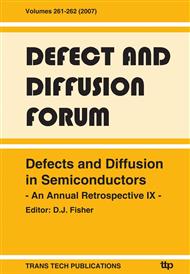p.1
p.25
p.31
p.37
p.47
p.55
p.61
p.77
p.85
Modeling of Diffusion Saturation of Titanium by Interstitial Elements under Rarefied Atmospheres
Abstract:
This paper deals with the development of a theoretical model for reactive diffusion during new-phase formation when its volume fraction is negligible. A mathematical analysis of this physical model is carried out and an equation for mass balance at the interface is derived. The latter includes a correlation between the transport flux of nitrogen to the surface (J1) followed by both diffusion dissolution (Jdiff) and segregation at the defects due to chemical interaction with metal atoms (JR.). The analytical-experimental procedure for the determination of the coefficient of mass transfer which controls the density of the outer flux (J1) is proposed. The effect of temperature and time upon the kinetics of nitriding is estimated. The additive dependences of both the nitrogen concentration in a distant band and the depth of the diffusion zone upon time, temperature and pressure during isothermal exposure are shown. Peculiarities of the nitrogen concentration distribution at the interface, as a function of temperature of isothermal exposure, are found. It is established that, for a given duration of exposure, an increase in temperature does not always tend to increase the concentration of the impurity at the interface. This is caused by a more intense diffusion flow into the matrix. In accordance with the concept of time-independence of the surface concentration during saturation, the diffusion fluxes Jdiff → ∞ with decreasing time (τ→ 0). This artefact is eliminated by an equation, derived here, for a diffusion flux defined using new boundary conditions. The equations for calculating mass increase include the effect of segregation to the surface, which causes a deviation from a parabolic dependence of the mass change.
Info:
Periodical:
Pages:
47-54
Citation:
Online since:
January 2007
Authors:
Keywords:
Price:
Сopyright:
© 2007 Trans Tech Publications Ltd. All Rights Reserved
Share:
Citation:


